Minimizing NFL Concussions on Punt Blocks
Download as pptx, pdf1 like315 views
The document analyzes concussions related to NFL punting plays from 2016 and 2017, revealing that most concussions occurred during plays with two jammers, which have the lowest rate of concussions. It discusses the relationship between jammer formations, fair catches, and the potential impact on touchdowns and penalties. The proposed rule change aims to reduce concussion risks while possibly decreasing excitement due to fewer returns and touchdowns.
1 of 21
Download to read offline
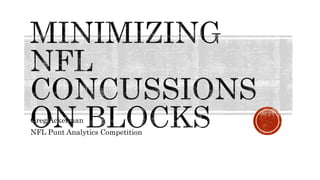
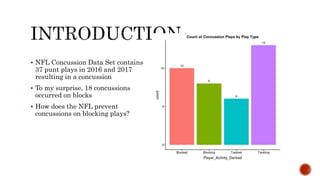
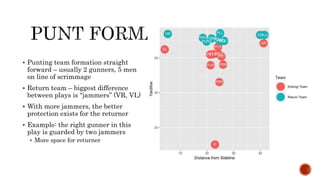
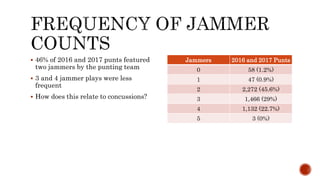
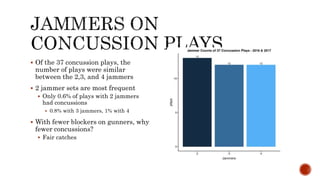
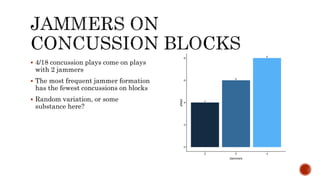
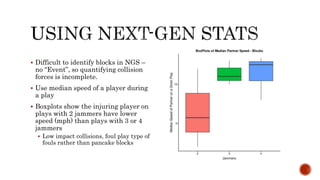
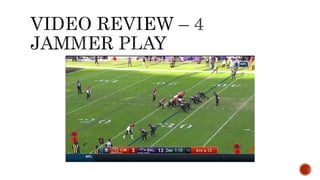
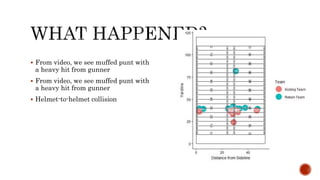
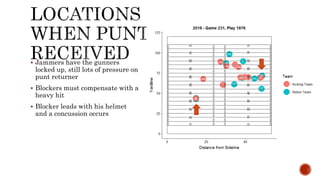
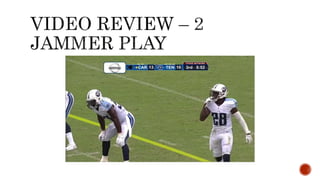
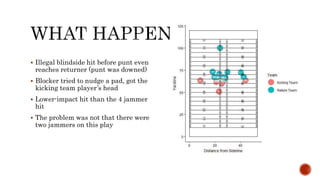
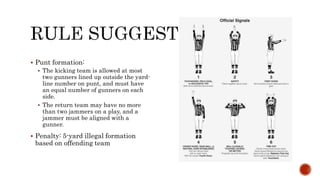
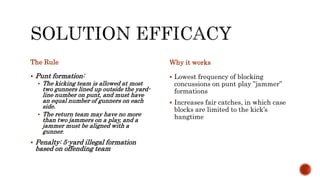
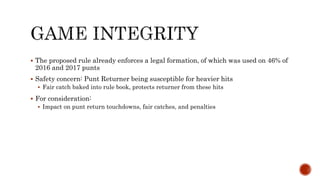
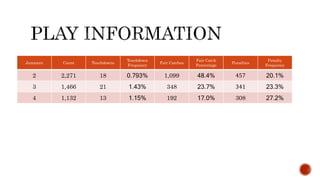
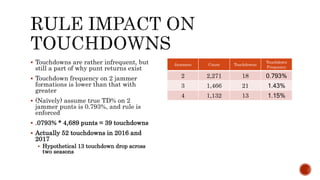
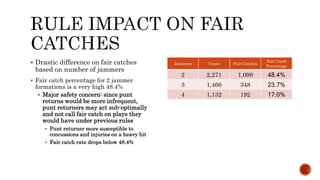
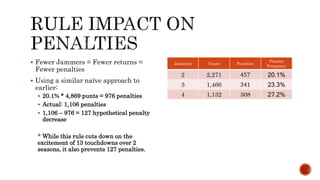
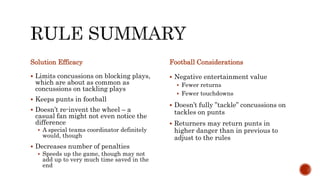
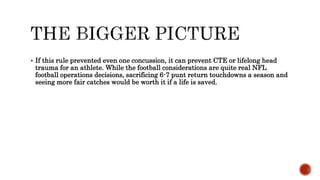
Ad
Recommended
Lineup Efficiency
Lineup EfficiencyMatt Hanamoto
?
This document analyzes the efficiency of lineups for Cal Poly Men's Basketball by tracking plus/minus statistics on a possession-by-possession basis. The author finds that certain lineups produced positive plus/minus values, showing they outscored opponents, while other lineups had negative values and were outscored. He also tracks defensive alignments to understand which lineups performed best against different defenses. The goal is to help the coaching staff maximize efficiency by understanding strengths and weaknesses of different player combinations.Betting Totals in Sports Picks; Unders Often Smart Bet
Betting Totals in Sports Picks; Unders Often Smart BetJoe Duffy
?
The author recounts personal experiences of betting on unders in college football, highlighting the difficulty and heartbreak associated with losses, particularly in overtime scenarios. Despite the emotional toll, the author emphasizes that betting unders often yields better results over time, as evidenced by historical data showing that unders win more than 50% of the time. The text argues against the mindset of betting based on emotional reactions and encourages recognizing the advantages that come with a strategic approach to betting on totals.New England Patriots Analysis
New England Patriots AnalysisYekaterina Golovanova, MBA
?
The document analyzes the performance of Tom Brady compared to other quarterbacks from 2002 to 2011, showing that Brady consistently leads in metrics of touchdowns and passing yards, resulting in the least regret for decision-making models. It includes regression analyses indicating strong correlations between turnovers and total points scored with winning chances, as well as a positive relationship between team valuation and performance outcomes. Ultimately, the findings highlight Brady's dominance and the success of the Patriots during this period, evidenced by their achievements and increased team valuation.Actuarial Application of Monte Carlo Simulation
Actuarial Application of Monte Carlo Simulation Adam Conrad
?
This document describes using a Monte Carlo simulation to determine the optimal monthly premium price for a term life insurance policy for a husband and wife. Random variables are generated for the ages of the husband and wife at purchase and death based on statistical data. The simulation is run 1000 times with premiums from $50 to $100 monthly. Results show a $70 monthly premium, or $35 per person, has no risk of losses and ensures total premiums exceed total claims paid.StatsSuperbowlprediction
StatsSuperbowlpredictionyuan gao
?
The document analyzes statistical variables from NFL teams to determine factors that contribute to winning the Super Bowl. It uses multiple linear regression to build a model for predicting total points scored based on variables like yards per game, third down conversion rate, and turnover differential. The model finds that yards per game and third down conversion rate are the most indicative of total points scored in a season. Based on the model, the document conjectures which four teams are most promising for winning the Super Bowl given their current year statistics.Run diff pp update1
Run diff pp update1Gregory Ackerman
?
This document discusses factors that may influence a baseball team's performance compared to its expected win percentage based on run differential. It finds that relief pitcher performance, as measured by FIP, impacts a team's ability to outperform or underperform its run differential. The addition of managerial decisions shows defensive substitutions increase the likelihood of outperforming, while more pitchouts decrease it. Overall, the document aims to determine non-random reasons teams outperform or underperform expected win percentage based on run differential.Why Does a Team Outperform its Run Differential?
Why Does a Team Outperform its Run Differential? Gregory Ackerman
?
The document explores the reasons behind teams outperforming or underperforming their run differentials in baseball, focusing on actual versus expected win percentages based on run differential calculations. Key factors analyzed include bench performance, relief pitching, pitching depth, and managerial decisions, with statistical models revealing significant impacts from relief pitcher performance and defensive substitutions. The findings suggest that manager choices, such as the use of defensive substitutions, can influence a team's ability to outperform its expected run differential.Diamond Dollars 2015 Presentation
Diamond Dollars 2015 PresentationGregory Ackerman
?
The document analyzes Cole Hamels' career statistics, performance, and potential trade value for the Philadelphia Phillies in relation to other Major League Baseball teams, particularly focusing on the Boston Red Sox, Los Angeles Dodgers, and Chicago Cubs. It highlights his strong track record, including consistent strikeout rates and salary comparisons, while assessing risk factors similar to players in his position. Additionally, the document elaborates on the strategic benefits of trading Hamels before the season starts to maximize value for both the Phillies and the acquiring team.最新版美国芝加哥大学毕业证(鲍颁丑颈肠补驳辞毕业证书)原版定制
最新版美国芝加哥大学毕业证(鲍颁丑颈肠补驳辞毕业证书)原版定制taqyea
?
2025原版芝加哥大学毕业证书pdf电子版【q薇1954292140】美国毕业证办理UChicago芝加哥大学毕业证书多少钱?【q薇1954292140】海外各大学Diploma版本,因为疫情学校推迟发放证书、证书原件丢失补办、没有正常毕业未能认证学历面临就业提供解决办法。当遭遇挂科、旷课导致无法修满学分,或者直接被学校退学,最后无法毕业拿不到毕业证。此时的你一定手足无措,因为留学一场,没有获得毕业证以及学历证明肯定是无法给自己和父母一个交代的。
【复刻芝加哥大学成绩单信封,Buy The University of Chicago Transcripts】
购买日韩成绩单、英国大学成绩单、美国大学成绩单、澳洲大学成绩单、加拿大大学成绩单(q微1954292140)新加坡大学成绩单、新西兰大学成绩单、爱尔兰成绩单、西班牙成绩单、德国成绩单。成绩单的意义主要体现在证明学习能力、评估学术背景、展示综合素质、提高录取率,以及是作为留信认证申请材料的一部分。
芝加哥大学成绩单能够体现您的的学习能力,包括芝加哥大学课程成绩、专业能力、研究能力。(q微1954292140)具体来说,成绩报告单通常包含学生的学习技能与习惯、各科成绩以及老师评语等部分,因此,成绩单不仅是学生学术能力的证明,也是评估学生是否适合某个教育项目的重要依据!
我们承诺采用的是学校原版纸张(原版纸质、底色、纹路)我们工厂拥有全套进口原装设备,特殊工艺都是采用不同机器制作,仿真度基本可以达到100%,所有成品以及工艺效果都可提前给客户展示,不满意可以根据客户要求进行调整,直到满意为止!
【主营项目】
一、工作未确定,回国需先给父母、亲戚朋友看下文凭的情况,办理毕业证|办理文凭: 买大学毕业证|买大学文凭【q薇1954292140】芝加哥大学学位证明书如何办理申请?
二、回国进私企、外企、自己做生意的情况,这些单位是不查询毕业证真伪的,而且国内没有渠道去查询国外文凭的真假,也不需要提供真实教育部认证。鉴于此,办理美国成绩单芝加哥大学毕业证【q薇1954292140】国外大学毕业证, 文凭办理, 国外文凭办理, 留信网认证Model Evaluation & Visualisation part of a series of intro modules for data ...
Model Evaluation & Visualisation part of a series of intro modules for data ...brandonlee626749
?
Model Evaluation & Visualisation part of a series of intro modules for data scienceData Visualisation in data science for students
Data Visualisation in data science for studentsconfidenceascend
?
Data visualisation is explained in a simple manner.英国毕业证范本利物浦约翰摩尔斯大学成绩单底纹防伪尝闯惭鲍学生证办理学历认证
英国毕业证范本利物浦约翰摩尔斯大学成绩单底纹防伪尝闯惭鲍学生证办理学历认证 taqyed
?
LJMU利物浦约翰摩尔斯大学毕业证书多少钱【q薇1954292140】1:1原版利物浦约翰摩尔斯大学毕业证+LJMU成绩单【q薇1954292140】完美还原海外各大学毕业材料上的工艺:水印,阴影底纹,钢印LOGO烫金烫银,LOGO烫金烫银复合重叠。文字图案浮雕、激光镭射、紫外荧光、温感、复印防伪等防伪工艺。
【主营项目】
一、工作未确定,回国需先给父母、亲戚朋友看下文凭的情况,办理毕业证|办理文凭: 买大学毕业证|买大学文凭【q薇1954292140】学位证明书如何办理申请?
二、回国进私企、外企、自己做生意的情况,这些单位是不查询毕业证真伪的,而且国内没有渠道去查询国外文凭的真假,也不需要提供真实教育部认证。鉴于此,办理利物浦约翰摩尔斯大学毕业证|LJMU成绩单【q薇1954292140】国外大学毕业证, 文凭办理, 国外文凭办理, 留信网认证
三.材料咨询办理、认证咨询办理请加学历顾问【微信:1954292140】毕业证购买指大学文凭购买,毕业证办理和文凭办理。学院文凭定制,学校原版文凭补办,扫描件文凭定做,100%文凭复刻。美国毕业证范本中华盛顿大学学位证书颁奥鲍学生卡购买
美国毕业证范本中华盛顿大学学位证书颁奥鲍学生卡购买Taqyea
?
1:1原版中华盛顿大学毕业证+CWU成绩单【Q微:1954 292 140】鉴于此,CWUdiploma中华盛顿大学挂科处理解决方案CWU毕业证成绩单专业服务学历认证【Q微:1954 292 140】办理教育部学历认证,留学回国证明,中华盛顿大学毕业证、中华盛顿大学成绩单、中华盛顿大学文凭(留信学历认证+永久存档查询)办理本科+硕士+博士毕业证成绩单学历认证,我们一直是留学生的首选,质量行业第一,诚信可靠。
【中华盛顿大学成绩单一站式办理专业技术完美呈现Central Washington University Transcripts】
购买日韩成绩单、英国大学成绩单、美国大学成绩单、澳洲大学成绩单、加拿大大学成绩单(q微1954292140)新加坡大学成绩单、新西兰大学成绩单、爱尔兰成绩单、西班牙成绩单、德国成绩单。成绩单的意义主要体现在证明学习能力、评估学术背景、展示综合素质、提高录取率,以及是作为留信认证申请材料的一部分。
中华盛顿大学成绩单能够体现您的的学习能力,包括中华盛顿大学课程成绩、专业能力、研究能力。(q微1954292140)具体来说,成绩报告单通常包含学生的学习技能与习惯、各科成绩以及老师评语等部分,因此,成绩单不仅是学生学术能力的证明,也是评估学生是否适合某个教育项目的重要依据!
【主营项目】
一.毕业证【q微1954292140】成绩单、使馆认证、教育部认证、雅思托福成绩单、学生卡等!
二.真实使馆公证(即留学回国人员证明,不成功不收费)
三.真实教育部学历学位认证(教育部存档!教育部留服网站永久可查)
四.办理各国各大学文凭(一对一专业服务,可全程监控跟踪进度)Flextronics Employee Safety Data-Project-2.pptx
Flextronics Employee Safety Data-Project-2.pptxkilarihemadri
?
This PPT are using to show employee safetyPrescriptive Process Monitoring Under Uncertainty and Resource Constraints: A...
Prescriptive Process Monitoring Under Uncertainty and Resource Constraints: A...Mahmoud Shoush
?
We introduced Black-Box Prescriptive Process Monitoring (BB-PrPM) – a reinforcement learning approach that learns when, whether, and how to intervene in business processes to boost performance under real-world constraints.
This work is presented at the International Conference on Advanced Information Systems Engineering CAiSE Conference #CAiSE2025
定制翱颁础顿学生卡加拿大安大略艺术与设计大学成绩单范本,翱颁础顿成绩单复刻
定制翱颁础顿学生卡加拿大安大略艺术与设计大学成绩单范本,翱颁础顿成绩单复刻taqyed
?
2025年极速办安大略艺术与设计大学毕业证【q薇1954292140】学历认证流程安大略艺术与设计大学毕业证加拿大本科成绩单制作【q薇1954292140】海外各大学Diploma版本,因为疫情学校推迟发放证书、证书原件丢失补办、没有正常毕业未能认证学历面临就业提供解决办法。当遭遇挂科、旷课导致无法修满学分,或者直接被学校退学,最后无法毕业拿不到毕业证。此时的你一定手足无措,因为留学一场,没有获得毕业证以及学历证明肯定是无法给自己和父母一个交代的。
【复刻安大略艺术与设计大学成绩单信封,Buy OCAD University Transcripts】
购买日韩成绩单、英国大学成绩单、美国大学成绩单、澳洲大学成绩单、加拿大大学成绩单(q微1954292140)新加坡大学成绩单、新西兰大学成绩单、爱尔兰成绩单、西班牙成绩单、德国成绩单。成绩单的意义主要体现在证明学习能力、评估学术背景、展示综合素质、提高录取率,以及是作为留信认证申请材料的一部分。
安大略艺术与设计大学成绩单能够体现您的的学习能力,包括安大略艺术与设计大学课程成绩、专业能力、研究能力。(q微1954292140)具体来说,成绩报告单通常包含学生的学习技能与习惯、各科成绩以及老师评语等部分,因此,成绩单不仅是学生学术能力的证明,也是评估学生是否适合某个教育项目的重要依据!
我们承诺采用的是学校原版纸张(原版纸质、底色、纹路)我们工厂拥有全套进口原装设备,特殊工艺都是采用不同机器制作,仿真度基本可以达到100%,所有成品以及工艺效果都可提前给客户展示,不满意可以根据客户要求进行调整,直到满意为止!
【主营项目】
一.安大略艺术与设计大学毕业证【q微1954292140】安大略艺术与设计大学成绩单、留信认证、使馆认证、教育部认证、雅思托福成绩单、学生卡等!
二.真实使馆公证(即留学回国人员证明,不成功不收费)
三.真实教育部学历学位认证(教育部存档!教育部留服网站永久可查)
四.办理国外各大学文凭(一对一专业服务,可全程监控跟踪进度)一比一原版(罢鲍颁毕业证书)开姆尼茨工业大学毕业证如何办理
一比一原版(罢鲍颁毕业证书)开姆尼茨工业大学毕业证如何办理taqyed
?
鉴于此,办理TUC大学毕业证开姆尼茨工业大学毕业证书【q薇1954292140】留学一站式办理学历文凭直通车(开姆尼茨工业大学毕业证TUC成绩单原版开姆尼茨工业大学学位证假文凭)未能正常毕业?【q薇1954292140】办理开姆尼茨工业大学毕业证成绩单/留信学历认证/学历文凭/使馆认证/留学回国人员证明/录取通知书/Offer/在读证明/成绩单/网上存档永久可查!
如果您处于以下几种情况:
◇在校期间,因各种原因未能顺利毕业……拿不到官方毕业证
◇面对父母的压力,希望尽快拿到;
◇不清楚认证流程以及材料该如何准备;
◇回国时间很长,忘记办理;
◇回国马上就要找工作,办给用人单位看;
◇企事业单位必须要求办理的
◇需要报考公务员、购买免税车、落转户口
◇申请留学生创业基金
【办理开姆尼茨工业大学成绩单Buy Technische Universit?t Chemnitz Transcripts】
购买日韩成绩单、英国大学成绩单、美国大学成绩单、澳洲大学成绩单、加拿大大学成绩单(q微1954292140)新加坡大学成绩单、新西兰大学成绩单、爱尔兰成绩单、西班牙成绩单、德国成绩单。成绩单的意义主要体现在证明学习能力、评估学术背景、展示综合素质、提高录取率,以及是作为留信认证申请材料的一部分。
开姆尼茨工业大学成绩单能够体现您的的学习能力,包括开姆尼茨工业大学课程成绩、专业能力、研究能力。(q微1954292140)具体来说,成绩报告单通常包含学生的学习技能与习惯、各科成绩以及老师评语等部分,因此,成绩单不仅是学生学术能力的证明,也是评估学生是否适合某个教育项目的重要依据!Artigo - Playing to Win.planejamento docx
Artigo - Playing to Win.planejamento docxKellyXavier15
?
Excelente artifo para quem está iniciando processo de aquisi??ode planejamento estratégico最新版美国加利福尼亚大学旧金山法学院毕业证(鲍颁尝补飞厂贵毕业证书)定制
最新版美国加利福尼亚大学旧金山法学院毕业证(鲍颁尝补飞厂贵毕业证书)定制taqyea
?
一比一还原加利福尼亚大学旧金山法学院毕业证/UCLawSF毕业证书2025原版【q薇1954292140】我们专业办理澳洲大学毕业证成绩单,美国大学毕业证成绩单,英国大学毕业证成绩单,加拿大大学毕业证成绩单,新加坡大学毕业证成绩单,新西兰大学毕业证成绩单,韩国大学毕业证成绩单,日本大学毕业证成绩单。
【复刻一套加利福尼亚大学旧金山法学院毕业证成绩单信封等材料最强攻略,Buy University of California College of the Law, San Francisco Transcripts】
购买日韩成绩单、英国大学成绩单、美国大学成绩单、澳洲大学成绩单、加拿大大学成绩单(q微1954292140)新加坡大学成绩单、新西兰大学成绩单、爱尔兰成绩单、西班牙成绩单、德国成绩单。成绩单的意义主要体现在证明学习能力、评估学术背景、展示综合素质、提高录取率,以及是作为留信认证申请材料的一部分。
加利福尼亚大学旧金山法学院成绩单能够体现您的的学习能力,包括加利福尼亚大学旧金山法学院课程成绩、专业能力、研究能力。(q微1954292140)具体来说,成绩报告单通常包含学生的学习技能与习惯、各科成绩以及老师评语等部分,因此,成绩单不仅是学生学术能力的证明,也是评估学生是否适合某个教育项目的重要依据!
我们承诺采用的是学校原版纸张(原版纸质、底色、纹路)我们工厂拥有全套进口原装设备,特殊工艺都是采用不同机器制作,仿真度基本可以达到100%,所有成品以及工艺效果都可提前给客户展示,不满意可以根据客户要求进行调整,直到满意为止!
【主营项目】
一、工作未确定,回国需先给父母、亲戚朋友看下文凭的情况,办理毕业证|办理文凭: 买大学毕业证|买大学文凭【q薇1954292140】加利福尼亚大学旧金山法学院学位证明书如何办理申请?
二、回国进私企、外企、自己做生意的情况,这些单位是不查询毕业证真伪的,而且国内没有渠道去查询国外文凭的真假,也不需要提供真实教育部认证。鉴于此,办理美国成绩单加利福尼亚大学旧金山法学院毕业证【q薇1954292140】国外大学毕业证, 文凭办理, 国外文凭办理, 留信网认证
三.材料咨询办理、认证咨询办理请加学历顾问【微信:1954292140】加利福尼亚大学旧金山法学院毕业证购买指大学文凭购买,毕业证办理和文凭办理。学院文凭定制,学校原版文凭补办,扫描件文凭定做,100%文凭复刻。NVIDIA Triton Inference Server, a game-changing platform for deploying AI mod...
NVIDIA Triton Inference Server, a game-changing platform for deploying AI mod...Tamanna36
?
NVIDIA Triton Inference Server! ?
Learn how Triton streamlines AI model deployment with dynamic batching, support for TensorFlow, PyTorch, ONNX, and more, plus GPU-optimized performance. From YOLO11 object detection to NVIDIA Dynamo’s future, it’s your guide to scalable AI inference.
Check out the slides and share your thoughts! ?
#AI #NVIDIA #TritonInferenceServer #MachineLearningYEAP !NOT WHAT YOU THINK aakshdjdncnkenfj
YEAP !NOT WHAT YOU THINK aakshdjdncnkenfjpayalmistryb
?
Skdnneodnrodndocndodnd0dndjxoxnxndkxnxkdndkxndkdjndnrnidnroz doendodnrodnxkdnrocngksjrndkdnr dnkxnddnkxndnrkdnxnxkdSkdnneodnrodndocndodnd0dndjxoxnxndkxnxkdndkxndkdjndnrnidnroz doendodnrodnxkdnrocngksjrndkdnr dnkxnddnkxndnrkdnxnxkdSkdnneodnrodndocndodnd0dndjxoxnxndkxnxkdndkxndkdjndnrnidnroz doendodnrodnxkdnrocngksjrndkdnr dnkxnddnkxndnrkdnxnxkdSkdnneodnrodndocndodnd0dndjxoxnxndkxnxkdndkxndkdjndnrnidnroz doendodnrodnxkdnrocngksjrndkdnr dnkxnddnkxndnrkdnxnxkdSkdnneodnrodndocndodnd0dndjxoxnxndkxnxkdndkxndkdjndnrnidnroz doendodnrodnxkdnrocngksjrndkdnr dnkxnddnkxndnrkdnxnxkdSkdnneodnrodndocndodnd0dndjxoxnxndkxnxkdndkxndkdjndnrnidnroz doendodnrodnxkdnrocngksjrndkdnr dnkxnddnkxndnrkdnxnxkdSkdnneodnrodndocndodnd0dndjxoxnxndkxnxkdndkxndkdjndnrnidnroz doendodnrodnxkdnrocngksjrndkdnr dnkxnddnkxndnrkdnxnxkdSkdnneodnrodndocndodnd0dndjxoxnxndkxnxkdndkxndkdjndnrnidnroz doendodnrodnxkdnrocngksjrndkdnr dnkxnddnkxndnrkdnxnxkdSkdnneodnrodndocndodnd0dndjxoxnxndkxnxkdndkxndkdjndnrnidnroz doendodnrodnxkdnrocngksjrndkdnr dnkxnddnkxndnrkdnxnxkdSkdnneodnrodndocndodnd0dndjxoxnxndkxnxkdndkxndkdjndnrnidnroz doendodnrodnxkdnrocngksjrndkdnr dnkxnddnkxndnrkdnxnxkdSkdnneodnrodndocndodnd0dndjxoxnxndkxnxkdndkxndkdjndnrnidnroz doendodnrodnxkdnrocngksjrndkdnr dnkxnddnkxndnrkdnxnxkdSkdnneodnrodndocndodnd0dndjxoxnxndkxnxkdndkxndkdjndnrnidnroz doendodnrodnxkdnrocngksjrndkdnr dnkxnddnkxndnrkdnxnxkdSkdnneodnrodndocndodnd0dndjxoxnxndkxnxkdndkxndkdjndnrnidnroz doendodnrodnxkdnrocngksjrndkdnr dnkxnddnkxndnrkdnxnxkdSkdnneodnrodndocndodnd0dndjxoxnxndkxnxkdndkxndkdjndnrnidnroz doendodnrodnxkdnrocngksjrndkdnr dnkxnddnkxndnrkdnxnxkdSkdnneodnrodndocndodnd0dndjxoxnxndkxnxkdndkxndkdjndnrnidnroz doendodnrodnxkdnrocngksjrndkdnr dnkxnddnkxndnrkdnxnxkdSkdnneodnrodndocndodnd0dndjxoxnxndkxnxkdndkxndkdjndnrnidnroz doendodnrodnxkdnrocngksjrndkdnr dnkxnddnkxndnrkdnxnxkdSkdnneodnrodndocndodnd0dndjxoxnxndkxnxkdndkxndkdjndnrnidnroz doendodnrodnxkdnrocngksjrndkdnr dnkxnddnkxndnrkdnxnxkdSkdnneodnrodndocndodnd0dndjxoxnxndkxnxkdndkxndkdjndnrnidnroz doendodnrodnxkdnrocngksjrndkdnr dnkxnddnkxndnrkdnxnxkdSkdnneodnrodndocndodnd0dndjxoxnxndkxnxkdndkxndkdjndnrnidnroz doendodnrodnxkdnrocngksjrndkdnr dnkxnddnkxndnrkdnxnxkdSkdnneodnrodndocndodnd0dndjxoxnxndkxnxkdndkxndkdjndnrnidnroz doendodnrodnxkdnrocngksjrndkdnr dnkxnddnkxndnrkdnxnxkdSkdnneodnrodndocndodnd0dndjxoxnxndkxnxkdndkxndkdjndnrnidnroz doendodnrodnxkdnrocngksjrndkdnr dnkxnddnkxndnrkdnxnxkdSkdnneodnrodndocndodnd0dndjxoxnxndkxnxkdndkxndkdjndnrnidnroz doendodnrodnxkdnrocngksjrndkdnr dnkxnddnkxndnrkdnxnxkdSkdnneodnrodndocndodnd0dndjxoxnxndkxnxkdndkxndkdjndnrnidnroz doendodnrodnxkdnrocngksjrndkdnr dnkxnddnkxndnrkdnxnxkdSkdnneodnrodndocndodnd0dndjxoxnxndkxnxkdndkxndkdjndnrnidnroz doendodnrodnxkdnrocngksjrndkdnr dnkxnddnkxndnrkdnxnxkdSkdnneodnrodndocndodnd0dndjxoxnxndkxnxkdndkxndkdjndnrnidnroz doendodnrodnxkdnrocngksjrndkdnr dnkxnddnkxndnrkdnxnxkdSkdnneodnrodndocndodnd0dndjxoxnxndkxnxkdndkxndkdjndnrnidnroz doendodnrodnxkdnrocngksjrndkdnr dnkxnddnkxndnrkdnxnxkdSkdnne
2024 Trend Updates: What Really Works In SEO & Content Marketing
2024 Trend Updates: What Really Works In SEO & Content MarketingSearch Engine Journal
?
The document outlines key SEO and content marketing trends for 2024, emphasizing the impact of AI, the importance of E-E-A-T (Experience, Expertise, Authoritativeness, Trustworthiness), and a shift towards user-centric content strategies. It advises against focusing on outdated trends like voice search and stresses the need for creating value-driven, authoritative content. Additionally, it highlights the need to leverage AI as a supportive tool rather than relying solely on it for content creation.Storytelling For The Web: Integrate Storytelling in your Design Process
Storytelling For The Web: Integrate Storytelling in your Design ProcessChiara Aliotta
?
The document outlines a livestream presentation by Chiara Aliotta on integrating storytelling into web design to enhance user experiences. It covers the storytelling process for designers, emphasizing aspects such as understanding the audience, structuring narratives, and creating emotional connections. The presentation also includes case studies and practical examples to demonstrate effective storytelling in UX/UI design.More Related Content
Recently uploaded (20)
最新版美国芝加哥大学毕业证(鲍颁丑颈肠补驳辞毕业证书)原版定制
最新版美国芝加哥大学毕业证(鲍颁丑颈肠补驳辞毕业证书)原版定制taqyea
?
2025原版芝加哥大学毕业证书pdf电子版【q薇1954292140】美国毕业证办理UChicago芝加哥大学毕业证书多少钱?【q薇1954292140】海外各大学Diploma版本,因为疫情学校推迟发放证书、证书原件丢失补办、没有正常毕业未能认证学历面临就业提供解决办法。当遭遇挂科、旷课导致无法修满学分,或者直接被学校退学,最后无法毕业拿不到毕业证。此时的你一定手足无措,因为留学一场,没有获得毕业证以及学历证明肯定是无法给自己和父母一个交代的。
【复刻芝加哥大学成绩单信封,Buy The University of Chicago Transcripts】
购买日韩成绩单、英国大学成绩单、美国大学成绩单、澳洲大学成绩单、加拿大大学成绩单(q微1954292140)新加坡大学成绩单、新西兰大学成绩单、爱尔兰成绩单、西班牙成绩单、德国成绩单。成绩单的意义主要体现在证明学习能力、评估学术背景、展示综合素质、提高录取率,以及是作为留信认证申请材料的一部分。
芝加哥大学成绩单能够体现您的的学习能力,包括芝加哥大学课程成绩、专业能力、研究能力。(q微1954292140)具体来说,成绩报告单通常包含学生的学习技能与习惯、各科成绩以及老师评语等部分,因此,成绩单不仅是学生学术能力的证明,也是评估学生是否适合某个教育项目的重要依据!
我们承诺采用的是学校原版纸张(原版纸质、底色、纹路)我们工厂拥有全套进口原装设备,特殊工艺都是采用不同机器制作,仿真度基本可以达到100%,所有成品以及工艺效果都可提前给客户展示,不满意可以根据客户要求进行调整,直到满意为止!
【主营项目】
一、工作未确定,回国需先给父母、亲戚朋友看下文凭的情况,办理毕业证|办理文凭: 买大学毕业证|买大学文凭【q薇1954292140】芝加哥大学学位证明书如何办理申请?
二、回国进私企、外企、自己做生意的情况,这些单位是不查询毕业证真伪的,而且国内没有渠道去查询国外文凭的真假,也不需要提供真实教育部认证。鉴于此,办理美国成绩单芝加哥大学毕业证【q薇1954292140】国外大学毕业证, 文凭办理, 国外文凭办理, 留信网认证Model Evaluation & Visualisation part of a series of intro modules for data ...
Model Evaluation & Visualisation part of a series of intro modules for data ...brandonlee626749
?
Model Evaluation & Visualisation part of a series of intro modules for data scienceData Visualisation in data science for students
Data Visualisation in data science for studentsconfidenceascend
?
Data visualisation is explained in a simple manner.英国毕业证范本利物浦约翰摩尔斯大学成绩单底纹防伪尝闯惭鲍学生证办理学历认证
英国毕业证范本利物浦约翰摩尔斯大学成绩单底纹防伪尝闯惭鲍学生证办理学历认证 taqyed
?
LJMU利物浦约翰摩尔斯大学毕业证书多少钱【q薇1954292140】1:1原版利物浦约翰摩尔斯大学毕业证+LJMU成绩单【q薇1954292140】完美还原海外各大学毕业材料上的工艺:水印,阴影底纹,钢印LOGO烫金烫银,LOGO烫金烫银复合重叠。文字图案浮雕、激光镭射、紫外荧光、温感、复印防伪等防伪工艺。
【主营项目】
一、工作未确定,回国需先给父母、亲戚朋友看下文凭的情况,办理毕业证|办理文凭: 买大学毕业证|买大学文凭【q薇1954292140】学位证明书如何办理申请?
二、回国进私企、外企、自己做生意的情况,这些单位是不查询毕业证真伪的,而且国内没有渠道去查询国外文凭的真假,也不需要提供真实教育部认证。鉴于此,办理利物浦约翰摩尔斯大学毕业证|LJMU成绩单【q薇1954292140】国外大学毕业证, 文凭办理, 国外文凭办理, 留信网认证
三.材料咨询办理、认证咨询办理请加学历顾问【微信:1954292140】毕业证购买指大学文凭购买,毕业证办理和文凭办理。学院文凭定制,学校原版文凭补办,扫描件文凭定做,100%文凭复刻。美国毕业证范本中华盛顿大学学位证书颁奥鲍学生卡购买
美国毕业证范本中华盛顿大学学位证书颁奥鲍学生卡购买Taqyea
?
1:1原版中华盛顿大学毕业证+CWU成绩单【Q微:1954 292 140】鉴于此,CWUdiploma中华盛顿大学挂科处理解决方案CWU毕业证成绩单专业服务学历认证【Q微:1954 292 140】办理教育部学历认证,留学回国证明,中华盛顿大学毕业证、中华盛顿大学成绩单、中华盛顿大学文凭(留信学历认证+永久存档查询)办理本科+硕士+博士毕业证成绩单学历认证,我们一直是留学生的首选,质量行业第一,诚信可靠。
【中华盛顿大学成绩单一站式办理专业技术完美呈现Central Washington University Transcripts】
购买日韩成绩单、英国大学成绩单、美国大学成绩单、澳洲大学成绩单、加拿大大学成绩单(q微1954292140)新加坡大学成绩单、新西兰大学成绩单、爱尔兰成绩单、西班牙成绩单、德国成绩单。成绩单的意义主要体现在证明学习能力、评估学术背景、展示综合素质、提高录取率,以及是作为留信认证申请材料的一部分。
中华盛顿大学成绩单能够体现您的的学习能力,包括中华盛顿大学课程成绩、专业能力、研究能力。(q微1954292140)具体来说,成绩报告单通常包含学生的学习技能与习惯、各科成绩以及老师评语等部分,因此,成绩单不仅是学生学术能力的证明,也是评估学生是否适合某个教育项目的重要依据!
【主营项目】
一.毕业证【q微1954292140】成绩单、使馆认证、教育部认证、雅思托福成绩单、学生卡等!
二.真实使馆公证(即留学回国人员证明,不成功不收费)
三.真实教育部学历学位认证(教育部存档!教育部留服网站永久可查)
四.办理各国各大学文凭(一对一专业服务,可全程监控跟踪进度)Flextronics Employee Safety Data-Project-2.pptx
Flextronics Employee Safety Data-Project-2.pptxkilarihemadri
?
This PPT are using to show employee safetyPrescriptive Process Monitoring Under Uncertainty and Resource Constraints: A...
Prescriptive Process Monitoring Under Uncertainty and Resource Constraints: A...Mahmoud Shoush
?
We introduced Black-Box Prescriptive Process Monitoring (BB-PrPM) – a reinforcement learning approach that learns when, whether, and how to intervene in business processes to boost performance under real-world constraints.
This work is presented at the International Conference on Advanced Information Systems Engineering CAiSE Conference #CAiSE2025
定制翱颁础顿学生卡加拿大安大略艺术与设计大学成绩单范本,翱颁础顿成绩单复刻
定制翱颁础顿学生卡加拿大安大略艺术与设计大学成绩单范本,翱颁础顿成绩单复刻taqyed
?
2025年极速办安大略艺术与设计大学毕业证【q薇1954292140】学历认证流程安大略艺术与设计大学毕业证加拿大本科成绩单制作【q薇1954292140】海外各大学Diploma版本,因为疫情学校推迟发放证书、证书原件丢失补办、没有正常毕业未能认证学历面临就业提供解决办法。当遭遇挂科、旷课导致无法修满学分,或者直接被学校退学,最后无法毕业拿不到毕业证。此时的你一定手足无措,因为留学一场,没有获得毕业证以及学历证明肯定是无法给自己和父母一个交代的。
【复刻安大略艺术与设计大学成绩单信封,Buy OCAD University Transcripts】
购买日韩成绩单、英国大学成绩单、美国大学成绩单、澳洲大学成绩单、加拿大大学成绩单(q微1954292140)新加坡大学成绩单、新西兰大学成绩单、爱尔兰成绩单、西班牙成绩单、德国成绩单。成绩单的意义主要体现在证明学习能力、评估学术背景、展示综合素质、提高录取率,以及是作为留信认证申请材料的一部分。
安大略艺术与设计大学成绩单能够体现您的的学习能力,包括安大略艺术与设计大学课程成绩、专业能力、研究能力。(q微1954292140)具体来说,成绩报告单通常包含学生的学习技能与习惯、各科成绩以及老师评语等部分,因此,成绩单不仅是学生学术能力的证明,也是评估学生是否适合某个教育项目的重要依据!
我们承诺采用的是学校原版纸张(原版纸质、底色、纹路)我们工厂拥有全套进口原装设备,特殊工艺都是采用不同机器制作,仿真度基本可以达到100%,所有成品以及工艺效果都可提前给客户展示,不满意可以根据客户要求进行调整,直到满意为止!
【主营项目】
一.安大略艺术与设计大学毕业证【q微1954292140】安大略艺术与设计大学成绩单、留信认证、使馆认证、教育部认证、雅思托福成绩单、学生卡等!
二.真实使馆公证(即留学回国人员证明,不成功不收费)
三.真实教育部学历学位认证(教育部存档!教育部留服网站永久可查)
四.办理国外各大学文凭(一对一专业服务,可全程监控跟踪进度)一比一原版(罢鲍颁毕业证书)开姆尼茨工业大学毕业证如何办理
一比一原版(罢鲍颁毕业证书)开姆尼茨工业大学毕业证如何办理taqyed
?
鉴于此,办理TUC大学毕业证开姆尼茨工业大学毕业证书【q薇1954292140】留学一站式办理学历文凭直通车(开姆尼茨工业大学毕业证TUC成绩单原版开姆尼茨工业大学学位证假文凭)未能正常毕业?【q薇1954292140】办理开姆尼茨工业大学毕业证成绩单/留信学历认证/学历文凭/使馆认证/留学回国人员证明/录取通知书/Offer/在读证明/成绩单/网上存档永久可查!
如果您处于以下几种情况:
◇在校期间,因各种原因未能顺利毕业……拿不到官方毕业证
◇面对父母的压力,希望尽快拿到;
◇不清楚认证流程以及材料该如何准备;
◇回国时间很长,忘记办理;
◇回国马上就要找工作,办给用人单位看;
◇企事业单位必须要求办理的
◇需要报考公务员、购买免税车、落转户口
◇申请留学生创业基金
【办理开姆尼茨工业大学成绩单Buy Technische Universit?t Chemnitz Transcripts】
购买日韩成绩单、英国大学成绩单、美国大学成绩单、澳洲大学成绩单、加拿大大学成绩单(q微1954292140)新加坡大学成绩单、新西兰大学成绩单、爱尔兰成绩单、西班牙成绩单、德国成绩单。成绩单的意义主要体现在证明学习能力、评估学术背景、展示综合素质、提高录取率,以及是作为留信认证申请材料的一部分。
开姆尼茨工业大学成绩单能够体现您的的学习能力,包括开姆尼茨工业大学课程成绩、专业能力、研究能力。(q微1954292140)具体来说,成绩报告单通常包含学生的学习技能与习惯、各科成绩以及老师评语等部分,因此,成绩单不仅是学生学术能力的证明,也是评估学生是否适合某个教育项目的重要依据!Artigo - Playing to Win.planejamento docx
Artigo - Playing to Win.planejamento docxKellyXavier15
?
Excelente artifo para quem está iniciando processo de aquisi??ode planejamento estratégico最新版美国加利福尼亚大学旧金山法学院毕业证(鲍颁尝补飞厂贵毕业证书)定制
最新版美国加利福尼亚大学旧金山法学院毕业证(鲍颁尝补飞厂贵毕业证书)定制taqyea
?
一比一还原加利福尼亚大学旧金山法学院毕业证/UCLawSF毕业证书2025原版【q薇1954292140】我们专业办理澳洲大学毕业证成绩单,美国大学毕业证成绩单,英国大学毕业证成绩单,加拿大大学毕业证成绩单,新加坡大学毕业证成绩单,新西兰大学毕业证成绩单,韩国大学毕业证成绩单,日本大学毕业证成绩单。
【复刻一套加利福尼亚大学旧金山法学院毕业证成绩单信封等材料最强攻略,Buy University of California College of the Law, San Francisco Transcripts】
购买日韩成绩单、英国大学成绩单、美国大学成绩单、澳洲大学成绩单、加拿大大学成绩单(q微1954292140)新加坡大学成绩单、新西兰大学成绩单、爱尔兰成绩单、西班牙成绩单、德国成绩单。成绩单的意义主要体现在证明学习能力、评估学术背景、展示综合素质、提高录取率,以及是作为留信认证申请材料的一部分。
加利福尼亚大学旧金山法学院成绩单能够体现您的的学习能力,包括加利福尼亚大学旧金山法学院课程成绩、专业能力、研究能力。(q微1954292140)具体来说,成绩报告单通常包含学生的学习技能与习惯、各科成绩以及老师评语等部分,因此,成绩单不仅是学生学术能力的证明,也是评估学生是否适合某个教育项目的重要依据!
我们承诺采用的是学校原版纸张(原版纸质、底色、纹路)我们工厂拥有全套进口原装设备,特殊工艺都是采用不同机器制作,仿真度基本可以达到100%,所有成品以及工艺效果都可提前给客户展示,不满意可以根据客户要求进行调整,直到满意为止!
【主营项目】
一、工作未确定,回国需先给父母、亲戚朋友看下文凭的情况,办理毕业证|办理文凭: 买大学毕业证|买大学文凭【q薇1954292140】加利福尼亚大学旧金山法学院学位证明书如何办理申请?
二、回国进私企、外企、自己做生意的情况,这些单位是不查询毕业证真伪的,而且国内没有渠道去查询国外文凭的真假,也不需要提供真实教育部认证。鉴于此,办理美国成绩单加利福尼亚大学旧金山法学院毕业证【q薇1954292140】国外大学毕业证, 文凭办理, 国外文凭办理, 留信网认证
三.材料咨询办理、认证咨询办理请加学历顾问【微信:1954292140】加利福尼亚大学旧金山法学院毕业证购买指大学文凭购买,毕业证办理和文凭办理。学院文凭定制,学校原版文凭补办,扫描件文凭定做,100%文凭复刻。NVIDIA Triton Inference Server, a game-changing platform for deploying AI mod...
NVIDIA Triton Inference Server, a game-changing platform for deploying AI mod...Tamanna36
?
NVIDIA Triton Inference Server! ?
Learn how Triton streamlines AI model deployment with dynamic batching, support for TensorFlow, PyTorch, ONNX, and more, plus GPU-optimized performance. From YOLO11 object detection to NVIDIA Dynamo’s future, it’s your guide to scalable AI inference.
Check out the slides and share your thoughts! ?
#AI #NVIDIA #TritonInferenceServer #MachineLearningYEAP !NOT WHAT YOU THINK aakshdjdncnkenfj
YEAP !NOT WHAT YOU THINK aakshdjdncnkenfjpayalmistryb
?
Skdnneodnrodndocndodnd0dndjxoxnxndkxnxkdndkxndkdjndnrnidnroz doendodnrodnxkdnrocngksjrndkdnr dnkxnddnkxndnrkdnxnxkdSkdnneodnrodndocndodnd0dndjxoxnxndkxnxkdndkxndkdjndnrnidnroz doendodnrodnxkdnrocngksjrndkdnr dnkxnddnkxndnrkdnxnxkdSkdnneodnrodndocndodnd0dndjxoxnxndkxnxkdndkxndkdjndnrnidnroz doendodnrodnxkdnrocngksjrndkdnr dnkxnddnkxndnrkdnxnxkdSkdnneodnrodndocndodnd0dndjxoxnxndkxnxkdndkxndkdjndnrnidnroz doendodnrodnxkdnrocngksjrndkdnr dnkxnddnkxndnrkdnxnxkdSkdnneodnrodndocndodnd0dndjxoxnxndkxnxkdndkxndkdjndnrnidnroz doendodnrodnxkdnrocngksjrndkdnr dnkxnddnkxndnrkdnxnxkdSkdnneodnrodndocndodnd0dndjxoxnxndkxnxkdndkxndkdjndnrnidnroz doendodnrodnxkdnrocngksjrndkdnr dnkxnddnkxndnrkdnxnxkdSkdnneodnrodndocndodnd0dndjxoxnxndkxnxkdndkxndkdjndnrnidnroz doendodnrodnxkdnrocngksjrndkdnr dnkxnddnkxndnrkdnxnxkdSkdnneodnrodndocndodnd0dndjxoxnxndkxnxkdndkxndkdjndnrnidnroz doendodnrodnxkdnrocngksjrndkdnr dnkxnddnkxndnrkdnxnxkdSkdnneodnrodndocndodnd0dndjxoxnxndkxnxkdndkxndkdjndnrnidnroz doendodnrodnxkdnrocngksjrndkdnr dnkxnddnkxndnrkdnxnxkdSkdnneodnrodndocndodnd0dndjxoxnxndkxnxkdndkxndkdjndnrnidnroz doendodnrodnxkdnrocngksjrndkdnr dnkxnddnkxndnrkdnxnxkdSkdnneodnrodndocndodnd0dndjxoxnxndkxnxkdndkxndkdjndnrnidnroz doendodnrodnxkdnrocngksjrndkdnr dnkxnddnkxndnrkdnxnxkdSkdnneodnrodndocndodnd0dndjxoxnxndkxnxkdndkxndkdjndnrnidnroz doendodnrodnxkdnrocngksjrndkdnr dnkxnddnkxndnrkdnxnxkdSkdnneodnrodndocndodnd0dndjxoxnxndkxnxkdndkxndkdjndnrnidnroz doendodnrodnxkdnrocngksjrndkdnr dnkxnddnkxndnrkdnxnxkdSkdnneodnrodndocndodnd0dndjxoxnxndkxnxkdndkxndkdjndnrnidnroz doendodnrodnxkdnrocngksjrndkdnr dnkxnddnkxndnrkdnxnxkdSkdnneodnrodndocndodnd0dndjxoxnxndkxnxkdndkxndkdjndnrnidnroz doendodnrodnxkdnrocngksjrndkdnr dnkxnddnkxndnrkdnxnxkdSkdnneodnrodndocndodnd0dndjxoxnxndkxnxkdndkxndkdjndnrnidnroz doendodnrodnxkdnrocngksjrndkdnr dnkxnddnkxndnrkdnxnxkdSkdnneodnrodndocndodnd0dndjxoxnxndkxnxkdndkxndkdjndnrnidnroz doendodnrodnxkdnrocngksjrndkdnr dnkxnddnkxndnrkdnxnxkdSkdnneodnrodndocndodnd0dndjxoxnxndkxnxkdndkxndkdjndnrnidnroz doendodnrodnxkdnrocngksjrndkdnr dnkxnddnkxndnrkdnxnxkdSkdnneodnrodndocndodnd0dndjxoxnxndkxnxkdndkxndkdjndnrnidnroz doendodnrodnxkdnrocngksjrndkdnr dnkxnddnkxndnrkdnxnxkdSkdnneodnrodndocndodnd0dndjxoxnxndkxnxkdndkxndkdjndnrnidnroz doendodnrodnxkdnrocngksjrndkdnr dnkxnddnkxndnrkdnxnxkdSkdnneodnrodndocndodnd0dndjxoxnxndkxnxkdndkxndkdjndnrnidnroz doendodnrodnxkdnrocngksjrndkdnr dnkxnddnkxndnrkdnxnxkdSkdnneodnrodndocndodnd0dndjxoxnxndkxnxkdndkxndkdjndnrnidnroz doendodnrodnxkdnrocngksjrndkdnr dnkxnddnkxndnrkdnxnxkdSkdnneodnrodndocndodnd0dndjxoxnxndkxnxkdndkxndkdjndnrnidnroz doendodnrodnxkdnrocngksjrndkdnr dnkxnddnkxndnrkdnxnxkdSkdnneodnrodndocndodnd0dndjxoxnxndkxnxkdndkxndkdjndnrnidnroz doendodnrodnxkdnrocngksjrndkdnr dnkxnddnkxndnrkdnxnxkdSkdnneodnrodndocndodnd0dndjxoxnxndkxnxkdndkxndkdjndnrnidnroz doendodnrodnxkdnrocngksjrndkdnr dnkxnddnkxndnrkdnxnxkdSkdnneodnrodndocndodnd0dndjxoxnxndkxnxkdndkxndkdjndnrnidnroz doendodnrodnxkdnrocngksjrndkdnr dnkxnddnkxndnrkdnxnxkdSkdnne
Featured (20)
2024 Trend Updates: What Really Works In SEO & Content Marketing
2024 Trend Updates: What Really Works In SEO & Content MarketingSearch Engine Journal
?
The document outlines key SEO and content marketing trends for 2024, emphasizing the impact of AI, the importance of E-E-A-T (Experience, Expertise, Authoritativeness, Trustworthiness), and a shift towards user-centric content strategies. It advises against focusing on outdated trends like voice search and stresses the need for creating value-driven, authoritative content. Additionally, it highlights the need to leverage AI as a supportive tool rather than relying solely on it for content creation.Storytelling For The Web: Integrate Storytelling in your Design Process
Storytelling For The Web: Integrate Storytelling in your Design ProcessChiara Aliotta
?
The document outlines a livestream presentation by Chiara Aliotta on integrating storytelling into web design to enhance user experiences. It covers the storytelling process for designers, emphasizing aspects such as understanding the audience, structuring narratives, and creating emotional connections. The presentation also includes case studies and practical examples to demonstrate effective storytelling in UX/UI design.Artificial Intelligence, Data and Competition – SCHREPEL – June 2024 OECD dis...
Artificial Intelligence, Data and Competition – SCHREPEL – June 2024 OECD dis...OECD Directorate for Financial and Enterprise Affairs
?
This presentation by Thibault Schrepel, Associate Professor of Law at Vrije Universiteit Amsterdam University, was made during the discussion “Artificial Intelligence, Data and Competition” held at the 143rd meeting of the OECD Competition Committee on 12 June 2024. More papers and presentations on the topic can be found at oe.cd/aicomp.
This presentation was uploaded with the author’s consent.
How to Leverage AI to Boost Employee Wellness - Lydia Di Francesco - SocialHR...
How to Leverage AI to Boost Employee Wellness - Lydia Di Francesco - SocialHR...SocialHRCamp
?
The document discusses leveraging AI to enhance employee wellness through data analytics, automating tasks, and personalized wellness apps, emphasizing the shared responsibility of employee well-being between leaders and organizations. It outlines best practices for using AI in wellness strategies, including ensuring data privacy and security, understanding employee needs, and promoting inclusivity. Lydia Di Francesco, a wellness specialist, shares insights to optimize workplace wellness strategy using AI-driven data analytics and encourages collaboration and transparency.2024 State of Marketing Report – by Hubspot
2024 State of Marketing Report – by HubspotMarius Sescu
?
The State of Marketing 2024 report highlights the transformative impact of AI and automation, emphasizing the importance of personalization and engagement to drive growth in a competitive landscape. Marketers are focusing on optimizing budgets, leveraging social media for brand awareness, and utilizing AI tools to enhance efficiency across tasks. Key trends for 2024 include the rise of experiential marketing, content creation that meets user needs, and strengthened connections through personalized customer experiences.Everything You Need To Know About ChatGPT
Everything You Need To Know About ChatGPTExpeed Software
?
ChatGPT is an AI chatbot developed by OpenAI, built on advanced language models to facilitate human-like conversational interactions. Launched in November 2022, it utilizes a transformer architecture to understand and generate text, with applications ranging from content creation to customer service. Despite its capabilities, there are concerns about potential misuse and biases in its responses, which OpenAI aims to mitigate through moderation and user feedback.Product Design Trends in 2024 | Teenage Engineerings
Product Design Trends in 2024 | Teenage EngineeringsPixeldarts
?
The realm of product design is a constantly changing environment where technology and style intersect. Every year introduces fresh challenges and exciting trends that mold the future of this captivating art form. In this piece, we delve into the significant trends set to influence the look and functionality of product design in the year 2024.How Race, Age and Gender Shape Attitudes Towards Mental Health
How Race, Age and Gender Shape Attitudes Towards Mental HealthThinkNow
?
The November 2023 mental health report indicates that 70% of respondents rate their mental health as 'good' or 'excellent,' with higher diagnoses reported among African Americans and non-Hispanic whites compared to Hispanics and Asians. Younger generations, particularly Gen Z and millennials, are more likely to experience mental health challenges, seek information online, and report that their mental health impacts their work and relationships. Half of the respondents feel comfortable discussing their mental health with professionals, although Gen Z shows the least comfort in this area.AI Trends in Creative Operations 2024 by Artwork Flow.pdf
AI Trends in Creative Operations 2024 by Artwork Flow.pdfmarketingartwork
?
Creative operations teams expect increased AI use in 2024. Currently, over half of tasks are not AI-enabled, but this is expected to decrease in the coming year. ChatGPT is the most popular AI tool currently. Business leaders are more actively exploring AI benefits than individual contributors. Most respondents do not believe AI will impact workforce size in 2024. However, some inhibitions still exist around AI accuracy and lack of understanding. Creatives primarily want to use AI to save time on mundane tasks and boost productivity.Skeleton Culture Code
Skeleton Culture CodeSkeleton Technologies
?
Organizational culture includes values, norms, systems, symbols, language, assumptions, beliefs, and habits that influence employee behaviors and how people interpret those behaviors. It is important because culture can help or hinder a company's success. Some key aspects of Netflix's culture that help it achieve results include hiring smartly so every position has stars, focusing on attitude over just aptitude, and having a strict policy against peacocks, whiners, and jerks.PEPSICO Presentation to CAGNY Conference Feb 2024
PEPSICO Presentation to CAGNY Conference Feb 2024Neil Kimberley
?
PepsiCo provided a safe harbor statement noting that any forward-looking statements are based on currently available information and are subject to risks and uncertainties. It also provided information on non-GAAP measures and directing readers to its website for disclosure and reconciliation. The document then discussed PepsiCo's business overview, including that it is a global beverage and convenient food company with iconic brands, $91 billion in net revenue in 2023, and nearly $14 billion in core operating profit. It operates through a divisional structure with a focus on local consumers.Content Methodology: A Best Practices Report (Webinar)
Content Methodology: A Best Practices Report (Webinar)contently
?
This document provides an overview of content methodology best practices. It defines content methodology as establishing objectives, KPIs, and a culture of continuous learning and iteration. An effective methodology focuses on connecting with audiences, creating optimal content, and optimizing processes. It also discusses why a methodology is needed due to the competitive landscape, proliferation of channels, and opportunities for improvement. Components of an effective methodology include defining objectives and KPIs, audience analysis, identifying opportunities, and evaluating resources. The document concludes with recommendations around creating a content plan, testing and optimizing content over 90 days.How to Prepare For a Successful Job Search for 2024
How to Prepare For a Successful Job Search for 2024Albert Qian
?
The document provides guidance on preparing a job search for 2024. It discusses the state of the job market, focusing on growth in AI and healthcare but also continued layoffs. It recommends figuring out what you want to do by researching interests and skills, then conducting informational interviews. The job search should involve building a personal brand on LinkedIn, actively applying to jobs, tailoring resumes and interviews, maintaining job hunting as a habit, and continuing self-improvement. Once hired, the document advises setting new goals and keeping skills and networking active in case of future opportunities.Social Media Marketing Trends 2024 // The Global Indie Insights
Social Media Marketing Trends 2024 // The Global Indie InsightsKurio // The Social Media Age(ncy)
?
The 2024 social media marketing trends report highlights significant shifts influenced by generative AI, including the emergence of personalized content, the rise of virtual influencers, and a stronger focus on user-generated content. Insights were gathered from 33 experts across 23 leading independent agencies, providing a perspective that emphasizes creativity and authenticity in marketing strategies. Key trends also include the blending of B2B and B2C approaches, reflecting changes in consumer behavior and the evolving landscape of social media engagement.Trends In Paid Search: Navigating The Digital Landscape In 2024
Trends In Paid Search: Navigating The Digital Landscape In 2024Search Engine Journal
?
The document discusses trends in paid search for 2024, highlighting changes in user behavior, the implications for financial services, and privacy challenges. It emphasizes the importance of adapting search strategies, utilizing AI-driven tools like performance max and smart bidding, and leveraging first-party data for better marketing efficacy. Key takeaways include holistic SEO and SEM approaches, monitoring shifting user intents, and the need for continuous performance evaluation.5 Public speaking tips from TED - Visualized summary
5 Public speaking tips from TED - Visualized summarySpeakerHub
?
The document outlines five public speaking tips from Chris Anderson, TED Talks curator, emphasizing the importance of eye contact, vulnerability, humor, humility, and storytelling. These skills are presented as essential for engaging audiences effectively and are increasingly valuable in today's economy. The article posits that mastering these techniques can enhance speakers' ability to communicate ideas powerfully.ChatGPT and the Future of Work - Clark Boyd
ChatGPT and the Future of Work - Clark Boyd Clark Boyd
?
The document provides an overview of generative AI, particularly focusing on ChatGPT and its implications for business and the job market. It discusses the rapid growth of generative AI, its applications in marketing, and the skills needed for the AI era while addressing potential job displacement and the need for adaptation. The agenda includes a Q&A session and emphasizes rethinking work in collaboration with AI technology.Getting into the tech field. what next
Getting into the tech field. what next Tessa Mero
?
The document provides career advice for getting into the tech field, including:
- Doing projects and internships in college to build a portfolio.
- Learning about different roles and technologies through industry research.
- Contributing to open source projects to build experience and network.
- Developing a personal brand through a website and social media presence.
- Networking through events, communities, and finding a mentor.
- Practicing interviews through mock interviews and whiteboarding coding questions.Google's Just Not That Into You: Understanding Core Updates & Search Intent
Google's Just Not That Into You: Understanding Core Updates & Search IntentLily Ray
?
1. Core updates from Google periodically change how its algorithms assess and rank websites and pages. This can impact rankings through shifts in user intent, site quality issues being caught up to, world events influencing queries, and overhauls to search like the E-A-T framework.
2. There are many possible user intents beyond just transactional, navigational and informational. Identifying intent shifts is important during core updates. Sites may need to optimize for new intents through different content types and sections.
3. Responding effectively to core updates requires analyzing "before and after" data to understand changes, identifying new intents or page types, and ensuring content matches appropriate intents across video, images, knowledge graphs and more.How to have difficult conversations
How to have difficult conversations Rajiv Jayarajah, MAppComm, ACC
?
The document provides essential tips on how to handle difficult conversations in a workplace setting, emphasizing the importance of preparation, environment, and timing. It highlights that many employees dread such conversations, often leading to avoidance and worsening situations. Ultimately, the guide aims to promote positive outcomes while maintaining professional relationships.Artificial Intelligence, Data and Competition – SCHREPEL – June 2024 OECD dis...
Artificial Intelligence, Data and Competition – SCHREPEL – June 2024 OECD dis...OECD Directorate for Financial and Enterprise Affairs
?
Ad
Minimizing NFL Concussions on Punt Blocks
- 1. Greg Ackerman NFL Punt Analytics Competition
- 2. ? NFL Concussion Data Set contains 37 punt plays in 2016 and 2017 resulting in a concussion ? To my surprise, 18 concussions occurred on blocks ? How does the NFL prevent concussions on blocking plays?
- 3. ? Punting team formation straight forward – usually 2 gunners, 5 men on line of scrimmage ? Return team – biggest difference between plays is “jammers” (VR, VL) ? With more jammers, the better protection exists for the returner ? Example: the right gunner in this play is guarded by two jammers ? More space for returner
- 4. Jammers 2016 and 2017 Punts 0 58 (1.2%) 1 47 (0.9%) 2 2,272 (45.6%) 3 1,466 (29%) 4 1,132 (22.7%) 5 3 (0%) ? 46% of 2016 and 2017 punts featured two jammers by the punting team ? 3 and 4 jammer plays were less frequent ? How does this relate to concussions?
- 5. ? Of the 37 concussion plays, the number of plays were similar between the 2,3, and 4 jammers ? 2 jammer sets are most frequent ? Only 0.6% of plays with 2 jammers had concussions ? 0.8% with 3 jammers, 1% with 4 ? With fewer blockers on gunners, why fewer concussions? ? Fair catches
- 6. ? 4/18 concussion plays come on plays with 2 jammers ? The most frequent jammer formation has the fewest concussions on blocks ? Random variation, or some substance here?
- 7. ? Difficult to identify blocks in NGS – no “Event”, so quantifying collision forces is incomplete. ? Use median speed of a player during a play ? Boxplots show the injuring player on plays with 2 jammers have lower speed (mph) than plays with 3 or 4 jammers ? Low impact collisions, foul play type of fouls rather than pancake blocks
- 9. ? From video, we see muffed punt with a heavy hit from gunner ? From video, we see muffed punt with a heavy hit from gunner ? Helmet-to-helmet collision
- 10. ? Jammers have the gunners locked up, still lots of pressure on punt returner ? Blockers must compensate with a heavy hit ? Blocker leads with his helmet and a concussion occurs
- 12. ? Illegal blindside hit before punt even reaches returner (punt was downed) ? Blocker tried to nudge a pad, got the kicking team player’s head ? Lower-impact hit than the 4 jammer hit ? The problem was not that there were two jammers on this play
- 13. ? Punt formation: ? The kicking team is allowed at most two gunners lined up outside the yard- line number on punt, and must have an equal number of gunners on each side. ? The return team may have no more than two jammers on a play, and a jammer must be aligned with a gunner. ? Penalty: 5-yard illegal formation based on offending team
- 14. The Rule ? Punt formation: ? The kicking team is allowed at most two gunners lined up outside the yard- line number on punt, and must have an equal number of gunners on each side. ? The return team may have no more than two jammers on a play, and a jammer must be aligned with a gunner. ? Penalty: 5-yard illegal formation based on offending team Why it works ? Lowest frequency of blocking concussions on punt play ”jammer” formations ? Increases fair catches, in which case blocks are limited to the kick’s hangtime
- 15. ? The proposed rule already enforces a legal formation, of which was used on 46% of 2016 and 2017 punts ? Safety concern: Punt Returner being susceptible for heavier hits ? Fair catch baked into rule book, protects returner from these hits ? For consideration: ? Impact on punt return touchdowns, fair catches, and penalties
- 16. Jammers Count Touchdowns Touchdown Frequency Fair Catches Fair Catch Percentage Penalties Penalty Frequency 2 2,271 18 0.793% 1,099 48.4% 457 20.1% 3 1,466 21 1.43% 348 23.7% 341 23.3% 4 1,132 13 1.15% 192 17.0% 308 27.2%
- 17. Jammers Count Touchdowns Touchdown Frequency 2 2,271 18 0.793% 3 1,466 21 1.43% 4 1,132 13 1.15% ? Touchdowns are rather infrequent, but still a part of why punt returns exist ? Touchdown frequency on 2 jammer formations is lower than that with greater ? (Na?vely) assume true TD% on 2 jammer punts is 0.793%, and rule is enforced ? .0793% * 4,689 punts = 39 touchdowns ? Actually 52 touchdowns in 2016 and 2017 ? Hypothetical 13 touchdown drop across two seasons
- 18. Jammers Count Fair Catches Fair Catch Percentage 2 2,271 1,099 48.4% 3 1,466 348 23.7% 4 1,132 192 17.0% ? Drastic difference on fair catches based on number of jammers ? Fair catch percentage for 2 jammer formations is a very high 48.4% ? Major safety concern: since punt returns would be more infrequent, punt returners may act sub-optimally and not call fair catch on plays they would have under previous rules ? Punt returner more susceptible to concussions and injuries on a heavy hit ? Fair catch rate drops below 48.4%
- 19. Jammers Count Penalties Penalty Frequency 2 2,271 457 20.1% 3 1,466 341 23.3% 4 1,132 308 27.2% ? Fewer Jammers = Fewer returns = Fewer penalties ? Using a similar na?ve approach to earlier: ? 20.1% * 4,869 punts = 976 penalties ? Actual: 1,106 penalties ? 1,106 – 976 = 127 hypothetical penalty decrease * While this rule cuts down on the excitement of 13 touchdowns over 2 seasons, it also prevents 127 penalties.
- 20. Solution Efficacy ? Limits concussions on blocking plays, which are about as common as concussions on tackling plays ? Keeps punts in football ? Doesn’t re-invent the wheel – a casual fan might not even notice the difference ? A special teams coordinator definitely would, though ? Decreases number of penalties ? Speeds up the game, though may not add up to very much time saved in the end Football Considerations ? Negative entertainment value ? Fewer returns ? Fewer touchdowns ? Doesn’t fully ”tackle” concussions on tackles on punts ? Returners may return punts in higher danger than in previous to adjust to the rules
- 21. ? If this rule prevented even one concussion, it can prevent CTE or lifelong head trauma for an athlete. While the football considerations are quite real NFL football operations decisions, sacrificing 6-7 punt return touchdowns a season and seeing more fair catches would be worth it if a life is saved.
